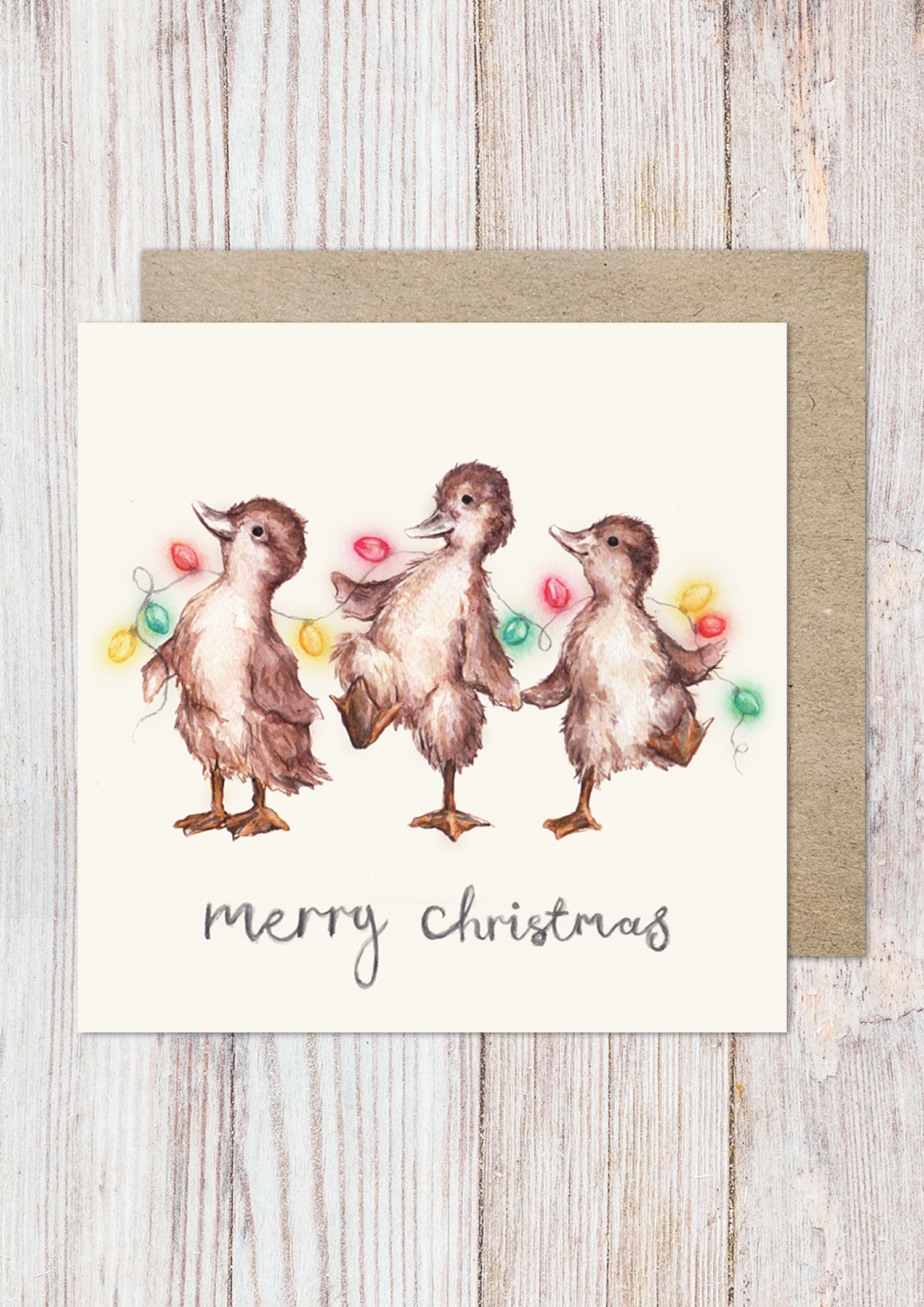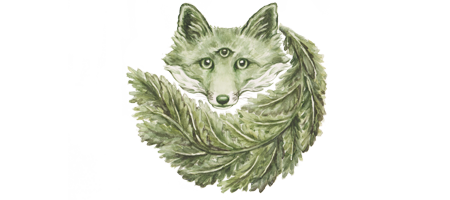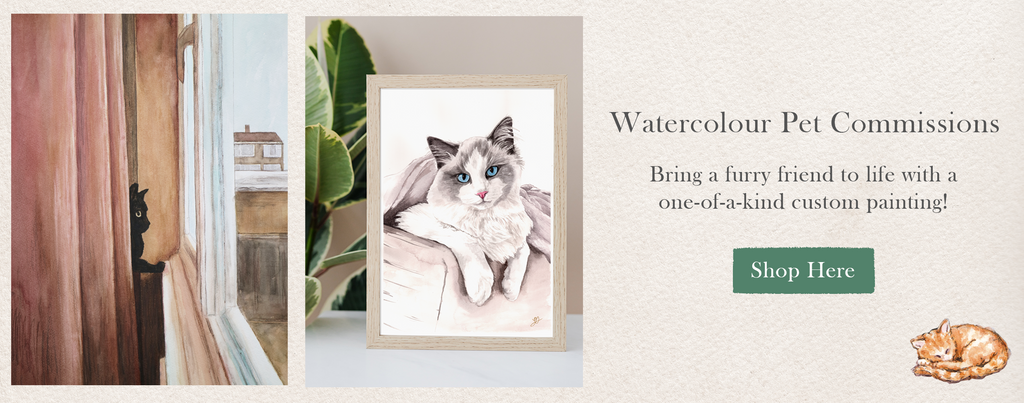In this blog post we will explore the wonderful medium of watercolor! it's characteristics, techniques, history, and why it is my favorite paint to work with.

Above: The Owl Guide Print
Watercolor art is like a dance of pigments and water. At it's most basic, watercolor art is a painting technique where watercolor paints (in the form of tubes, or pans) mixed with water are applied to paper, resulting in translucent layers that create a luminous effect. It is known for its fluidity, allowing for soft edges and gradients, and often requires layering to build depth and richness in colors. With its ethereal washes, vibrant hues, colourful blooms and bleeds it is one of the most enchanting and fun forms of painting. This medium, known for its unpredictability and spontaneity, is like a practice of taming chaos! It captivates both artists and viewers alike, but what exactly is watercolor art, and what makes it so special?
The Basics of Watercolor Art
At its core, watercolor painting involves pigments suspended in a water-based solution. Unlike oil or acrylic paints, watercolors are typically transparent and allow light to penetrate and reflect off the paper, creating a luminous, watery, and unique textured effect. The primary components of watercolor paint include:
- Pigment: These are the color particles, which can be derived from natural sources (like minerals and plants) or synthetic ones.
- Additives: Various substances can be added to modify the paint's characteristics, such as glycerin for a smoother flow or honey for increased viscosity.
The Techniques of Watercolor Painting
Watercolor artists use a variety of techniques to achieve different effects and textures, each contributing to the medium's unique charm:
- Wet-on-Wet: This involves applying wet paint onto a wet surface (wet watercolor paper). The colors bleed and blend in unpredictable ways, creating soft edges and fluid transitions, This watercolor duck painting is mostly painted using the wet on wet technique, you can see how the colors bleed and bloom, it is so much fun!

Above: Watercolor Duck Painting
- Glazing: This technique involves applying thin, transparent layers of the watecolor paint on top of one another. Each layer must dry before the next is applied, resulting in depth and rich, luminous colors. I used the glazing technique quite a lot when painting this wolf illustration, as you can see from the picture on the left the first layer is very light, after glazing a few more layers on top, as you can see from the picture on the right the result is a lot deeper, and rich in color.
- Dry Brush: Using a brush with minimal water, this technique creates a textured, grainy effect, perfect for adding details or texture, and great for a deep, high pigmented brush stroke!
The Allure of Watercolor
Watercolor art is celebrated for it's versatility and the unique qualities it brings to a painting:
- Transparency and Luminosity: The inherent transparency of watercolors allows for a play of light and color that other mediums struggle to replicate. The paper itself often becomes an integral part of the painting, shining through the layers of paint.
- Spontaneity and Expression: The fluid nature of watercolor encourages a level of spontaneity, and chaos, it can only be controlled so much, creating a dance between the artist, and the medium! For me, this is what makes a piece of watercolor art so exciting to paint, and to look at. When observing the painting I feel like you know this information deep down, and there is that feeling of being on the edge of your seat!
- Portability and Convenience: Watercolor supplies are relatively easy to transport, making it a favorite medium for plein air painters who capture the beauty of nature and landscapes, and also artist's who enjoy illustrating urban scenes, and capturing people going about their lives. These small watercolor pan palettes are great for this.

Above: Iris Watercolour Tea Towel
The History and Evolution
Watercolor has a rich history, dating back to ancient civilizations. Early examples can be found in Egyptian tombs, where pigments were mixed with water and applied to papyrus. The medium gained popularity during the Renaissance, with artists like Albrecht Dürer using it for detailed botanical studies and sketches.
In the 18th and 19th centuries, watercolor became particularly popular in England. Artists like J.M.W. Turner and John Constable used it to capture the changing light and atmosphere of the English countryside. Turner's innovative techniques, such as using washes to create luminous skies, helped elevate watercolor to a serious artistic medium.
Modern Watercolor
Today, watercolor remains a beloved medium, embraced by both traditional and contemporary artists. Advances in pigment technology have expanded the color range and permanence of watercolor paints. Contemporary artists, and illustrators push the boundaries of what can be achieved with watercolor, experimenting with techniques and surfaces to create bold, expressive works. A couple of my favourite watercolour artists include Sir Quentin Blake, and Charlie Mackesy.
Getting Started with Watercolor

Above: Watercolour Lithianthus Painting
For those looking to dive into the world of watercolor, starting can feel scary and intimidating, but it is actually relatively simple. Basic supplies include:
- Watercolor Paints: Available in tubes or pans, with a wide range of colors. My personal favourite's are the Winsor & Newton both the tubes, and pans, and the Schmincke tubes
- Brushes: Various shapes and sizes, made from natural or synthetic fibers. My favorite brushes are Black Velvet, Daler Rowney aquafine, and Winsor & Newton Cotman.
- Watercolor Paper: Typically heavier and more absorbent than standard paper, often made from cotton for durability. My favourite watercolour papers are Arches hot pressed, and Daler Rowney Langton.
- Palette: For mixing colors - a white ceramic palette all the way for me!
- Water and Tissues: Essential for cleaning brushes and adjusting paint consistency.
Beginners can experiment with the basic techniques and gradually explore more complex methods as they become more comfortable, and confident with the medium.
Watercolor art, with its contrast of precision and unpredictability, offers endless possibilities for creativity. Its delicate balance of control and chaos, light and color, makes it a truly magical form of expression. Whether you're a seasoned artist or a curious beginner, watercolor invites you to explore and discover the beauty that emerges when pigments dance with water!
Thank you for reading 'what is watercolor art?' I hope you enjoyed it.








